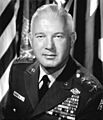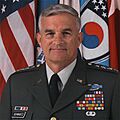United States Forces Korea facts for kids
Quick facts for kids United States Forces Korea주한 미군 |
|
|---|---|
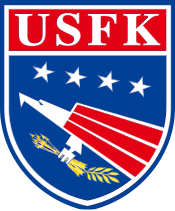
USFK
|
|
| Active | 1 July 1957 – present |
| Country | |
| Type | Subordinate Unified Command |
| Size | 23,468 personnel |
| Part of | United States Indo-Pacific Command |
| Headquarters | Camp Humphreys, Pyeongtaek, South Korea |
| Nickname(s) | USFK |
| Commanders | |
| Current commander |
|
| Deputy Commander | |
| Notable commanders |
GEN Vincent K. Brooks GEN George Decker GEN Hamilton H. Howze GEN John W. Vessey Jr. GEN John A. Wickham Jr. |
| Insignia | |
| Distinctive unit insignia | 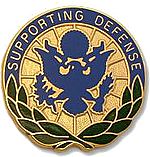 |
| Flag | 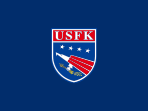 |
| United States Forces Korea | |
| Hangul | |
|---|---|
| Hanja | |
| Revised Romanization | Juhanmigun |
| McCune–Reischauer | Chuhanmigun |
United States Forces Korea (USFK) is a special military command. It brings together all the different parts of the U.S. military in South Korea. This includes soldiers, sailors, airmen, and Marines. USFK works closely with the South Korean military to protect the country. It was created on July 1, 1957.
The main job of USFK is to support the United Nations Command (UNC) and the Combined Forces Command. They help plan and work with all the U.S. military groups in Korea. They also control U.S. forces when the United States Indo-Pacific Command tells them to.
USFK has a special authority called "Title 10." This means USFK is in charge of getting U.S. forces in Korea ready. They make sure the forces are strong, can adapt quickly, and are always prepared.
About 28,500 American service members are in South Korea. This large presence shows how important the U.S. government thinks the Asia-Pacific region is. Another important part of USFK's mission is planning for emergencies. They prepare to help U.S. citizens and people from other agreed-upon countries leave if there is danger. To make sure this plan works well, USFK regularly practices these evacuation drills.
On June 29, 2018, the main offices for USFK and UNC moved. They are now at Camp Humphreys in Pyeongtaek. This means they are about 35 kilometers (22 miles) south of Seoul.
Contents
What is USFK's Mission?
USFK has several key missions in South Korea. These missions help keep peace and stability in the region.
- Supporting Allies: USFK works with the United Nations Command and the Combined Forces Command. These groups are important for defending South Korea.
- Coordinating Forces: USFK helps different U.S. military branches work together. This includes the Army, Navy, Air Force, and Marine Corps.
- Being Ready: USFK trains and equips U.S. forces in Korea. This makes sure they are always prepared for any situation.
- Protecting Citizens: USFK plans for emergencies where U.S. and other citizens might need to leave the country safely. They practice these plans often.
Leaders of USFK
Many important military leaders have commanded USFK since it started. These commanders are usually high-ranking generals from the United States Army. They play a big role in keeping the peace and working with South Korea. Some notable commanders have included GEN George Decker, GEN Hamilton H. Howze, GEN John W. Vessey Jr., GEN John A. Wickham Jr., and GEN Vincent K. Brooks. The current commander is GEN Paul J. LaCamera.
USFK Shoulder Patch
The shoulder patch worn by members of USFK tells a story. It is a shield-shaped design with special symbols.
What the Patch Looks Like
The patch is shaped like a shield. It has a blue background. At the top, there are four white stars. Below the stars, there is a picture of an American bald eagle. The eagle is red and white. Its head is white, and its eye is blue. The eagle holds a green branch and seven arrows. The whole patch has a thin white border. Above the shield, there is a red band with "USFK" written in white letters.
What the Symbols Mean
Every part of the USFK patch has a special meaning:
- Shield Shape: The shield shows that USFK is committed to protecting South Korea.
- "USFK" Letters: These letters stand for United States Forces Korea.
- Four Stars: The four stars represent the four main parts of the U.S. military that work together in Korea: the Army, Navy, Air Force, and Marine Corps.
- American Bald Eagle: The eagle shows how all these different military branches work together as one team.
- Laurel Branch and Arrows: The laurel branch (a symbol of peace) and the arrows (a symbol of defense) show that USFK's job is to keep the peace, but also to be ready to defend if needed.
- Colors:
- Red, white, and blue are the colors of the U.S. flag.
- Red means hard work and honor.
- White means innocence and purity.
- Blue means fairness and never giving up.
- Yellow (gold) means wisdom.
When the Patch Was Approved
The USFK shoulder patch was officially approved on June 18, 2012.
Images for kids








